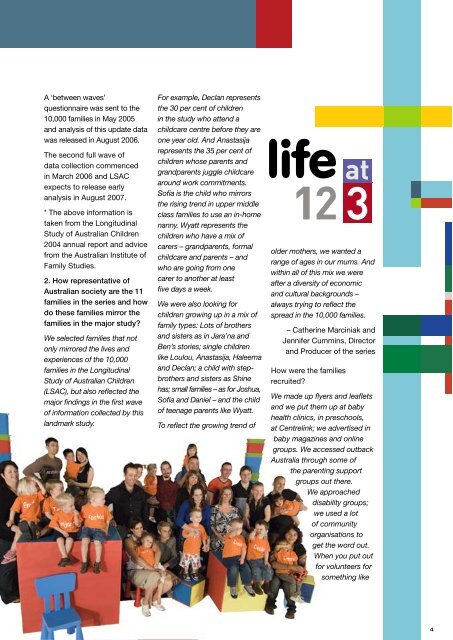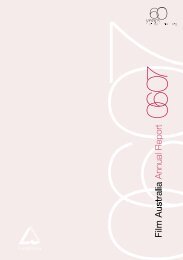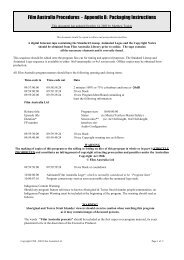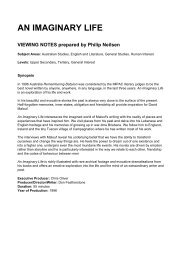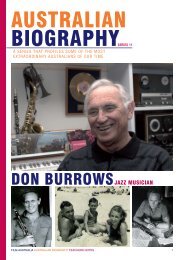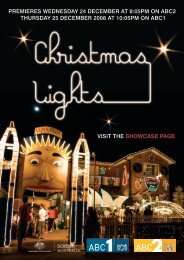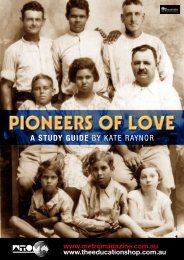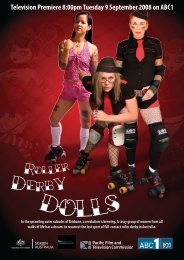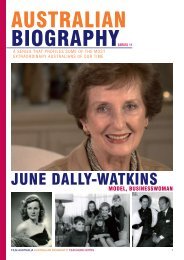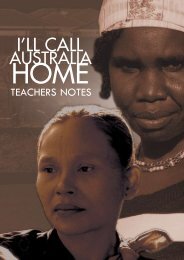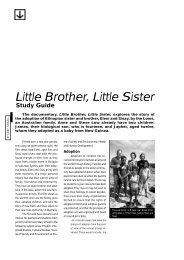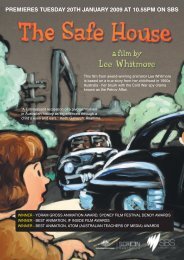Teachers Notes
Teachers Notes
Teachers Notes
You also want an ePaper? Increase the reach of your titles
YUMPU automatically turns print PDFs into web optimized ePapers that Google loves.
A ‘between waves’<br />
questionnaire was sent to the<br />
10,000 families in May 2005<br />
and analysis of this update data<br />
was released in August 2006.<br />
The second full wave of<br />
data collection commenced<br />
in March 2006 and LSAC<br />
expects to release early<br />
analysis in August 2007.<br />
* The above information is<br />
taken from the Longitudinal<br />
Study of Australian Children<br />
2004 annual report and advice<br />
from the Australian Institute of<br />
Family Studies.<br />
2. How representative of<br />
Australian society are the 11<br />
families in the series and how<br />
do these families mirror the<br />
families in the major study<br />
We selected families that not<br />
only mirrored the lives and<br />
experiences of the 10,000<br />
families in the Longitudinal<br />
Study of Australian Children<br />
(LSAC), but also reflected the<br />
major findings in the first wave<br />
of information collected by this<br />
landmark study.<br />
For example, Declan represents<br />
the 30 per cent of children<br />
in the study who attend a<br />
childcare centre before they are<br />
one year old. And Anastasija<br />
represents the 35 per cent of<br />
children whose parents and<br />
grandparents juggle childcare<br />
around work commitments.<br />
Sofia is the child who mirrors<br />
the rising trend in upper middle<br />
class families to use an in-home<br />
nanny. Wyatt represents the<br />
children who have a mix of<br />
carers – grandparents, formal<br />
childcare and parents – and<br />
who are going from one<br />
carer to another at least<br />
five days a week.<br />
We were also looking for<br />
children growing up in a mix of<br />
family types: Lots of brothers<br />
and sisters as in Jara’na and<br />
Ben’s stories; single children<br />
like Loulou, Anastasija, Haleema<br />
and Declan; a child with stepbrothers<br />
and sisters as Shine<br />
has; small families – as for Joshua,<br />
Sofia and Daniel – and the child<br />
of teenage parents like Wyatt.<br />
To reflect the growing trend of<br />
older mothers, we wanted a<br />
range of ages in our mums. And<br />
within all of this mix we were<br />
after a diversity of economic<br />
and cultural backgrounds –<br />
always trying to reflect the<br />
spread in the 10,000 families.<br />
– Catherine Marciniak and<br />
Jennifer Cummins, Director<br />
and Producer of the series<br />
How were the families<br />
recruited<br />
We made up flyers and leaflets<br />
and we put them up at baby<br />
health clinics, in preschools,<br />
at Centrelink; we advertised in<br />
baby magazines and online<br />
groups. We accessed outback<br />
Australia through some of<br />
the parenting support<br />
groups out there.<br />
We approached<br />
disability groups;<br />
we used a lot<br />
of community<br />
organisations to<br />
get the word out.<br />
When you put out<br />
for volunteers for<br />
something like<br />
4


